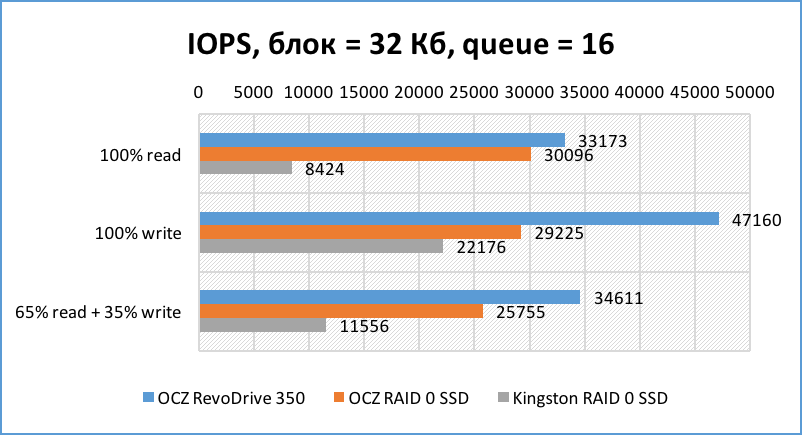SSD SATA vs. SSD PCI-E | Part three and final: server
The third post on the comparison of SSD drives with different interfaces will mainly consist of graphs. There was an open question about the need for precisely PCI-Express SSD drives in server systems. I will try to give an answer under the cut - the results of the research will dot the i.

The test bench is the same as in the previous part of the article:

')
The disks used in the tests:
PCIe: OCZ RevoDrive 350, 480 GB
SATA: 2 pieces OCZ Vector 150, 480 gigabytes, controller Barefoot 3
SATA: 2 pieces Kingston V300, 240 gigabytes, SandForce controller



In order to simulate the operation of the server servicing the SQL database, I will program the following script with the help of the IOMeter program. Large enough data blocks of 32 KB and 64 KB will create the following load cases:
The queue of requests: 8, 16 and 32.
Transaction ratio: 100% read, 100% write, 65% read + 35% write.
I measured the following values:
I think that these values are of interest for comparing the performance of the above-described solid-state drives.
Actually, the graphics:












Let me once again work as a captain Obvious. PCI-E is the best choice for working with databases, there is nothing to think about here. The good performance of RAID 0 from the two OCZ Vector drives show the inconsistency of SandForce in solving such problems. Normal desktop controller, no more.
I hope this article’s fascinating series of articles ends, wait for new posts, but for now read our previous works:
» OCZ ZD-XL SQL Accelerator. Enlarge your SQL
» Evolution of SSD Controllers
» SSD SATA vs. SSD PCI-E | part one: theoretical
» SSD SATA vs. SSD PCI-E | Part Two: Practical
» OCZ. We returned.

Test stand
The test bench is the same as in the previous part of the article:
- Processor: Intel Core i7 5960X
- Motherboard: ASUS Rampage V Extreme (drives connect to the chipset controller, PCIe disk is installed in the bottom slot x16)
- RAM: Corsair Vengeance DDR4-2800 C16 4 * 4 gigabytes
- System SSD: OCZ Vector 256Gb
- Video card: overall it doesn't matter, but I use XFX Radeon HD7970
- Power supply: Corsair AX1200i, 1200W
- Operating system: Windows 8.1 Professional (64-bit)

')
The disks used in the tests:
PCIe: OCZ RevoDrive 350, 480 GB
SATA: 2 pieces OCZ Vector 150, 480 gigabytes, controller Barefoot 3
SATA: 2 pieces Kingston V300, 240 gigabytes, SandForce controller



In order to simulate the operation of the server servicing the SQL database, I will program the following script with the help of the IOMeter program. Large enough data blocks of 32 KB and 64 KB will create the following load cases:
The queue of requests: 8, 16 and 32.
Transaction ratio: 100% read, 100% write, 65% read + 35% write.
I measured the following values:
- Total IOPS
- Average latency
I think that these values are of interest for comparing the performance of the above-described solid-state drives.
Actually, the graphics:
Block size - 32 KB, queue depth - 8 requests


Block size - 32 KB, queue depth - 16 requests


Block size - 32 KB, queue depth - 32 requests


Block size - 64 KB, queue depth - 8 requests


Block size - 64 KB, queue depth - 16 requests


Block size - 64 KB, queue depth - 32 requests


findings
Let me once again work as a captain Obvious. PCI-E is the best choice for working with databases, there is nothing to think about here. The good performance of RAID 0 from the two OCZ Vector drives show the inconsistency of SandForce in solving such problems. Normal desktop controller, no more.
I hope this article’s fascinating series of articles ends, wait for new posts, but for now read our previous works:
» OCZ ZD-XL SQL Accelerator. Enlarge your SQL
» Evolution of SSD Controllers
» SSD SATA vs. SSD PCI-E | part one: theoretical
» SSD SATA vs. SSD PCI-E | Part Two: Practical
» OCZ. We returned.
Source: https://habr.com/ru/post/365287/
All Articles